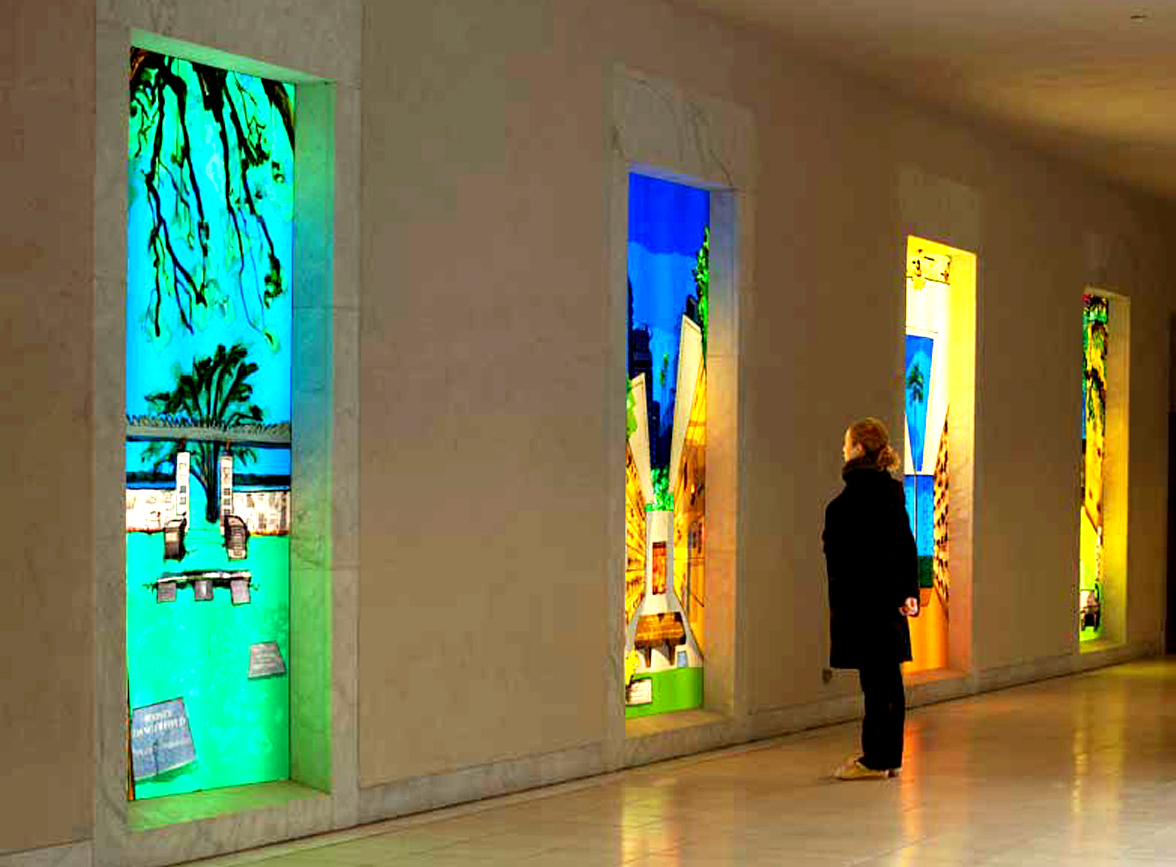
courtesy of T. KELLY MASON
T. Kelly Mason’s cartoon-like, light box project “Nocturne” is currently featured at the Hammer Museum through Sunday and will be used in conjunction with tonight’s panel. The project is inspired by grave markers from famous deceased Hollywood faces.
Head held high and camera in hand, L.A. artist T. Kelly Mason walks deliberately past rows of writers, directors and actors. He takes a few shots without their permission, not caring if he catches their good side, or even any side of them at all.
Publicity and appearance no longer appeal to these Hollywood stars, and neither does breathing.
Interred at Pierce Brothers Westwood Memorial Park, the likes of Marilyn Monroe and Rodney Dangerfield still demand an audience even in death, where their grave markers serve as references in Mason’s cartoon-like, light box project “Nocturne.”
Currently featured at the Hammer Museum until Sunday, these fluorescently backlit pictures will be used in conjunction with tonight’s panel discussion “Materializing the Immaterial,” which will address early 21st-century funerary practices and the differing methods of remembrance that follow. Mason and two other speakers will lead the panel.
“People have made choices about what to put on their mother’s tombstone, and to me, these are a lot like the choices that artists and writers make. You know this is important; you don’t have a lot of space. What are you going to say? That’s one of the main reasons I work with this material,” Mason said.
According to Mason, working with death as an art form allows him to reach viewers on multiple levels and evokes the natural feeling he is striving to recreate. He said a pictorial story unfolds by combining the morbid yet emotional concept of death with the other artistic elements in his light boxes.
This story found a willing listener in George Baker, an associate professor of art history and one of the other speakers featured at tonight’s panel.
“(The light boxes) seem very mid-century modern to me. They’re very much about cartoon languages … periods that refer back to childhood for a certain generation,” Baker said. “Mason’s interested in certain themes of the memorial, of how artists are called upon to make things and speak to history and the past.”
Baker’s unreleased book “Lateness and Longing: On the Afterlife of Photography” broaches the analog camera work of a few specific female photographers and their use of nostalgia in the visual medium, something which Baker said he believes Mason accomplishes as well.
Baker said he will discuss nostalgia’s relation to death and memory as well as the implications of nostalgia being more than just a feeling in which mourners “pine for the past.”
“Memory and memorialization is what I think this panel will speak about. It’s going to be an event about … the function of monuments in our culture, and the way in which artistic practice and memory can intersect,” Baker said.
Also exploring remembrance is the final speaker of the night, Tyler Cassity. As an undertaker and co-owner of Fernwood and Hollywood Forever cemeteries, Cassity has become somewhat of an expert on death in a career that he said he never saw himself pursuing ““ he was originally an aspiring writer and archival system software salesman.
Cassity said he finds Mason’s light boxes to be very reminiscent of an actual cemetery.
“Because (Mason) is using different materials, there’s a depth and even a spirituality to them that I didn’t expect. The further they envelop you, the more you start to figure out new messages,” Cassity said. “That also happens at a cemetery. … You’re responding to the environment and trying to condense it.”
Now Cassity said he condones two very different burial practices, one represented by Fernwood and the other by Hollywood Forever.
Where rocks serve as grave markers and biodegradable caskets as tombs, the natural burial grounds of Fernwood Cemetery cannot be further in principle from the more traditional marble tombstones and mausoleums of Hollywood Forever Cemetery.
“Hollywood Forever is very much an early 20th-century cemetery. … I like to think of it as a civic space of remembrance,” Cassity said. “At Fernwood, we took almost the entirety of the concept of national burials from Great Britain with the assumption that … just like the U.K. culture, we would experience a post-cremation trend.”
Cassity said he will likely elaborate more on these two differing practices at tonight’s panel but is unsure of where the discussion, like his career, will lead him.
“You never know what’s going to happen. I came to L.A. to sell software and I ended up with a lot of dirt, and more dirt.”
